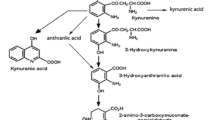Summary
L-5-Hydroxytryptophan (5HTP) and its major metabolites 5-hydroxytryptamine (5HT) and 5-hydroxyindoleaceticacid (5HIAA) were measured in blood and cerebrospinal fluid from neurological patients receiving steady state treatment with 5HTP. There was accumulation of 5HT in blood platelets and 5HIAA in plasma in all patients, despite concomitant administration of the L-aromatic amino acid decarboxylase inhibitors, carbidopa and benserazide. There was no correlation between the 5HTP dose and the circulating concentrations of the amino acid or its metabolites. Preliminary comparison of the biochemical and therapeutic effects of carbidopa versus benserazide suggest that 5HTP: carbidopa is superior to 5HTP: benserazide. A direct proportionality between plasma 5HTP concentrations and the levels of 5HTP in the lumbar cerebrospinal fluid was found. The binding to serum proteins of 5HTP in the clinically relevant concentration range of 10 to 100 µM was investigated; 19% of circulating 5HTP was bound to serum proteins. 5HTP did not displace protein-bound tryptophan in serum.
Similar content being viewed by others
References
Van Woert MH, Rosenbaum D (1979) L-5-Hydroxytryptophan terapy in myoclonus. Adv Neurol 26: 107–122
Magnussen I, Engbaek F (1978) The effects of aromatic amino acid decarboxylase inhibitors on plasma concentrations of 5-hydroxytryptophan in man. Acta Pharmacol Toxicol 43: 36–42
Magnussen I, Jensen TS, Rand JH, Van Woert MH (1981) Plasma accumulation and metabolism of orally single dose administered L-5-hydroxytryptophan in man. Acta Pharmacol Toxicol 49: 184–189
Magnussen I, Nielsen-Kudsk F (1980) Bioavailability and related pharmacokinetics in man of orally administered 5-hydroxytryptophan in steady state. Acta Pharmacol Toxicol 46: 257–262
Van Woert MH, Jutkowitz R, Rosenbaum D, Bowers MB (1976) Serotonin and myoclonus. Monogr Neural Sci 3: 71–80
Borga O, Azarnoff DL, Forshell GP, Sjöquist F (1969) Plasma protein binding of tricyclic antidepressants in man. Biomed Pharmacol 18: 2135–2143
Engbaek F, Magnussen I (1978) Determination of 5-hydroxytryptophan in plasma by high-performance liquid chromatography and fluorometric detection after phthaldialdehyde reaction. Clin Chem 24: 376–378
Shindo H, Komai T, Kawei K (1977) Mechanism of intestinal absorption and brain uptake of L-5-hydroxytryptophan in rats, as compared to those of L-3, 4-dihydoxyphenyl-alanine. Chem Pharm Bull 25: 1417–1425
Bianchine JR, Preziosi TJ, Hsu TH, Messine FS (1971) L-Alpha-methyldopa hydrazine (MK-486) and L-Dopa: A double-blind trial in parkinsonism. Pharmacologist 13: 231
Barbeau A (1973) Treatment of Parkinson's disease with L-DOPA and R04-4602. Review and present states. In: Jahr MD (ed) Adv. in Neurology, Vol. 2, Raven Press, New York, pp 173–198
Rosengren E (1960) Are dihydroxyphenylalanine decarboxylase and 5-hydroxytryptophan decarboxylase individual enzymes? Acta Physiol Scand 49: 364–369
Lovenberg W, Weissbach H, Udenfriend S (1962) Aromatic L-amino acid decarboxylase. J Biol Chem 237: 89–93
Born GAV, Gillson RE (1959) Studies in the uptake of 5-hydroxytryptamine by blood platelets. J Physiol (Lond) 146: 472–491
Costa JL, Stark H, Shafer B, Corash L, Smith MA, Murphy DL (1978) Maximal packet size for serotonin in storage vesicles of intact human platelets. Life Sci 23: 2193–2198
Marmaras VJ, Mimikos N (1971) Enzyme formation of serotonin in mammalian blood platelets and red cells. Experientia 27: 196–197
Paasonen MK (1973) Blood platelets as a model for aminergic neurons. In: Bloom FE, Acheson GH (ed) Pharmacology and the future of man, Vol. 4. S Karger, Basel, pp 328–342
Clark CT, Weissbach H, Udenfriend S (1954) 5-hydroxytryptophan decarboxylase: Preparation and properties. J Biol Chem 210: 139–148
Burkhard WP, Gey KF, Pletcher A (1964) Inhibition of decarboxylase of aromatic amino acids by 2, 3, 4-trihyoxybenzylhydrazine and its seryl derivative. J Biochem Biophs 107: 187–196
Porter CC (1973) Inhibitors of aromatic amino acid decarboxylase their biochemestry. Adv Neurol 2: 37–45
Wirz-Justice A, Puhringer W, Lacoste V, Graw P, Gastpar M (1976) Intravenous L-5-hydroxytryptophan in normal subjects: An interdisciplinary precursor loading study. Part III: Neuroendocrinological and biochemical changes. Pharmakopsychiatry 9: 277–288
Author information
Authors and Affiliations
Rights and permissions
About this article
Cite this article
Magnussen, I., Van Woert, M.H. Human pharmacokinetics of long term 5-hydroxytryptophan combined with decarboxylase inhibitors. Eur J Clin Pharmacol 23, 81–86 (1982). https://doi.org/10.1007/BF01061381
Received:
Accepted:
Issue Date:
DOI: https://doi.org/10.1007/BF01061381




